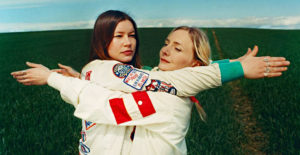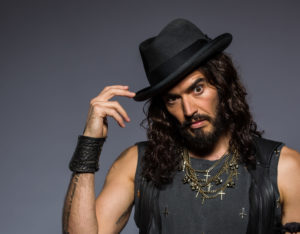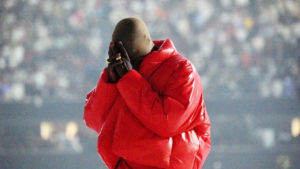This is a story about choices and consequences, so let’s start with DC’s decision in 1961 to publish a landmark issue of The Flash called “Flash of Two Worlds!” In the story, created by Gardner Fox and Carmen Infantino, the Flash of the Sixties (Barry Allen) meets the Flash of the Forties (Jay Garrick) by crossing from Earth-One to Earth-Two.
“As you know — two objects can occupy the same space and time — if they vibrate at different speeds!” Allen explains with a superhero’s typical fondness for exclamation marks. “My theory is, both Earths were created at the same time in two quite similar universes! They vibrate differently — which keeps them apart!” As the fastest man on (his) Earth, Allen vibrated so fast that he “tore a gap in the vibratory shields separating our worlds!”
Allen’s account of the physics may have been somewhat unreliable but readers didn’t flinch. Two worlds, two Flashes? Got it. That was how DC entered what the science-fiction writer Michael Moorcock would soon christen the “multiverse”.
Right now, the multiverse is box-office gold, as Doctor Strange and the Multiverse of Madness collides with the extraordinary word-of-mouth hit Everything Everywhere All At Once. The Marvel Cinematic Universe (MCU) has already been universe-hopping in Spider-Man: No Way Home and Loki; DC will follow suit with next year’s The Flash. While writing Everything Everywhere All At Once, directors Dan Kwan and Daniel Scheinert (known collectively as Daniels) saw multiverse storylines in Spider-Man: Into the Spider-Verse and Rick and Morty and worried that the concept would be old hat by the time their movie was out. Not a bit of it.
The multiverse began as an alternative answer to a confounding question. In the Twenties, experiments in the revolutionary new field of quantum mechanics demonstrated that sub-atomic particles such as electrons behaved as if they were in many places at once, like a waveform. Yet as soon as they were observed, these myriad coexisting possibilities concertinaed into a single, measurable state, which we call reality. How? In the traditional Copenhagen interpretation, the act of observation itself causes a phenomenon known as waveform collapse. This made sense to quantum physicists but not to anybody else.
One sceptic was Erwin Schrödinger. In 1935, he illustrated this paradox with a “ridiculous” thought experiment. A cat is placed in a box with a vial of lethal poison which will only break open if a radioactive atom decays. The odds are 50/50. If it were equally possible for the atom to have both decayed and not decayed until it is observed, Schrödinger argued, then it would be equally possible for the cat to be both alive and dead until the instant that the box is opened. Yet we instinctively feel that the unseen cat must be either alive or dead at any given moment, not alive and dead.
In a 1952 lecture, Schrödinger said something that he warned might seem mad: what if all the possibilities were real but we could only apprehend one of them? The quantum theorist, he said, talks about probabilities and alternatives. “The idea that they may not be alternatives but all really happen simultaneously seems lunatic to him, just impossible.”
Five years later, an American doctoral student called Hugh Everett proposed what became known as the many-worlds interpretation of quantum physics, later developed by Bryce DeWitt and David Deutsch. In this theory of the waveform, every possible outcome of every event, right down to the subatomic level, spawns a new universe. So the release of the poison in Schrödinger’s box splits off another universe: the cat is dead in one but still alive in the other. There are, in fact, innumerable cats in innumerable universes. In some of these universes, Schrödinger dies in the First World War, or is never born, and nobody has even heard of his cat. As John Gribbin puts it in his book Six Impossible Things: “an electron in a distant galaxy confronted with a choice of two (or more) quantum paths causes the entire Universe, including ourselves, to split. In the [many-worlds] version, there is an infinite variety of universes (a Multiverse) corresponding to all possible solutions to the quantum wave function.”
The popularity of the multiverse in superhero stories has less to do with physics than commerce. DC and Marvel embraced the concept as a means of rehabilitating old characters, fixing continuity errors and rewriting history. In the world of the central narrative (Earth-One in DC, Earth-616 in Marvel), numerous rules had to be obeyed (Don’t kill Spider-Man!) but in other universes writers could do whatever they liked. The problem was that these new universes accumulated their own inconsistencies while lowering the stakes across the board. If anything can happen, somewhere, then, as the nihilistic antagonist of Everything Everywhere All At Once says, “nothing matters”. The whole thing became such a mess that in 1985, DC swept the board clean and abolished the multiverse in Crisis on Infinite Earths. This comic-book take on waveform collapse was a neat solution, if mind-bogglingly genocidal if you thought about it for a minute.
By making the multiverse central to its Phase Four, the MCU runs that same risk of making the action both bewildering and inconsequential. Fortunately, the new Doctor Strange is anchored by a simple question asked by Scarlet Witch: “If you knew there was a universe where you were happy, wouldn’t you want to go there?” Demented by grief and regret, she says yes, of course. The rest of Sam Raimi’s movie, drenched in a 12-certificate brand of Lovecraftian interdimensional horror, tells us why she’s wrong.
Everything Everywhere All At Once also asks if there is a happier version of you, to a much wilder, funnier, sadder effect. Daniels have spoken about wanting to write a film that explored family dynamics, mental health and existential anxiety in the playfully philosophical spirit of Kurt Vonnegut, Charlie Kaufman and Douglas Adams, which is quite different from wanting to make a multiverse movie and working out what to put in it. In place of rock-solid superhero IP, their film gives us a fraught Chinese-American family which runs a failing laundrette. For Evelyn (Michelle Yeoh), preoccupied by “laundry and taxes”, the multiverse is not a known entity but a mind-bending revelation.
True to its title, Everything Everywhere All At Once is a whole lot of movie. It’s an absurdist comedy, a psychedelic action movie, a tender domestic drama, an allegory for the immigrant experience, a meta-commentary on cinema and a profound meditation on choices, regrets and the purpose of life. Whichever way you slice it, the grit that makes the pearl is Evelyn’s dissatisfaction with where her life has ended up, shadowed by the haunting awareness of bad decisions and wasted opportunities. “Across the multiverse, I’ve seen thousands of Evelyns,” says one version of her husband Waymond. “If you can imagine it, somewhere out there it exists.”
As far as we know, we are all blessed and cursed with only one life. We have opportunities to correct course or repair damage but every decision we make, from what to have for lunch to who to marry, is fundamentally irreversible. The 1998 romcom Sliding Doors, a multiverse movie in disguise, has become synonymous with the notion that an apparently insignificant decision or random incident can end up defining the course of a life.
Equally, the world has a single history. We all have to live with what has happened. In his novel Player Piano, Vonnegut describes “Why did it have to happen?” as “the question humanity had been asking for millenniums, the question men were seemingly born to ask”. Indeed, one character kicks off Doctor Strange by asking that very question: “Did it have to happen that way? Was there any other path?”
The appeal of the multiverse is that nothing had to happen, because in other universes it didn’t happen. It dramatises the contingency of history. Anything and everything could have been different and, somewhere out there, it is. “It’s a very confusing time,” says Stephanie Hsu, who plays Evelyn’s daughter Joy in Everything Everywhere All At Once, “so a multiverse story is a way of tapping into this question of, ‘Why is this reality the way that it is? Is it the only reality and does it work?’”
It seems to me that whenever something dismaying happens in the world, many people react by throwing themselves into the political multiverse. When a leaked opinion revealed that the Supreme Court was poised to overturn Roe v Wade and enable state legislatures to outlaw abortion, the sadness and outrage on Twitter produced a rash of counterfactuals that would have denied the conservative justices a majority: What if the Democrats had found a way to seat Merrick Garland in 2016? What if Hillary Clinton had won? What if Ruth Bader Ginsburg had retired under Obama rather than dying under Trump? What if? If only…
This happens all the time. Fans of Jeremy Corbyn routinely describe him as the best prime minister we never had. Democrats still torment themselves with the knowledge that a few thousand votes in Florida would have handed the White House to the environmentalist Al Gore rather than the neoconservative George W Bush. Geopolitical analysts, both professional and amateur, dream up scenarios in which Putin never invaded Ukraine. Covid partisans argue over whether lockdowns should have happened earlier or not at all, and what decisions in Wuhan might have obviated the question of lockdowns in the first place. We spend a lot of time mentally exploring the roads not taken — but is it time well spent?
Fundamental to politics is the desire to imagine a better future, and then to act to bring it about, but counterfactuals imagine a better past and present and there is nothing to be done about them. Compounding the impotence of the exercise is the fact that most of the people speculating on what could have been have never been in a position to make the fateful decision. I guess some people find it helpful to process the shouldas, wouldas and couldas, but to me it’s a form of horrendous masochism because it is too late to do anything and you never had the power to do anything in the first place.
The only useful counterfactual is the kind that teaches us lessons for the future. Modelling might-have-beens for Covid, for example, can help to prepare us for the next pandemic. More often, however, the exercise is about assigning blame and claiming foresight. It’s not so much “If only this hadn’t happened” as “If only you had listened to me”. Trump’s election victory in 2016 has been variously pinned on Hillary Clinton, the media, non-voters, Russian interference, James Comey and Susan Sarandon, to name just a few. The possible culprits behind Jeremy Corbyn’s failure include Blairites, Remainers and the media (again), as well as Corbyn himself. In the realm of counterfactuals, humility is a rare commodity. It’s unusual to find somebody who declares that if their advice had been heeded, then things would have been much worse.
The multiverse remains just a theory, albeit an increasingly popular one, because the existence of other universes has neither been confirmed nor disproved and, many quantum physicists argue, never can be. Some say that therefore it is not a scientific hypothesis at all but a philosophical concept. If, like the Flash, we could move between worlds, then we could know for sure where every possible branch in the road would have led and settle every argument for good. But we remain firmly stuck in the only universe we have ever known.
Not to spoil either movie, but both Everything Everywhere All At Once and Doctor Strange in the Multiverse of Madness wind up rejecting the escapism of the multiverse by suggesting that every alternative version of us has its own problems and that the most decent and rational choice is to learn to live better in our own universe. I think that’s the wisest response to the temptation of political counterfactuals as well: Here we are, like it or not. What do we do now?
Disclaimer
Some of the posts we share are controversial and we do not necessarily agree with them in the whole extend. Sometimes we agree with the content or part of it but we do not agree with the narration or language. Nevertheless we find them somehow interesting, valuable and/or informative or we share them, because we strongly believe in freedom of speech, free press and journalism. We strongly encourage you to have a critical approach to all the content, do your own research and analysis to build your own opinion.
We would be glad to have your feedback.
Source: UnHerd Read the original article here: https://unherd.com




